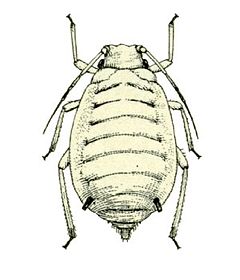Melanaphis sacchari
Melanaphis sacchari
Dessin de Melanaphis sacchari.
Melanaphis sacchari est une espèce d'insectes hémiptères de la famille des Aphididae (les pucerons).
Répartition
[modifier | modifier le code]Melanaphis sacchari se rencontre en Amérique, en Afrique, en Asie et en Australie[1].
Description
[modifier | modifier le code]Comme tous les pucerons, il s'alimente de la sève élaborée des plantes. Ses principales plantes hôtes appartiennent aux genres Saccharum (canne à sucre) et Sorghum (sorgho), mais il peut être rencontré sur d'autres Poaceae[2],[3].
Liste des sous-espèces
[modifier | modifier le code]Selon GBIF (23 septembre 2024)[4] :
- Melanaphis sacchari dassi
- Melanaphis sacchari indosacchari (David, 1956)
- Melanaphis sacchari sacchari (Zehntner, 1897)
Systématique
[modifier | modifier le code]Le nom valide complet (avec auteur) de ce taxon est Melanaphis sacchari (Zehntner, 1897)[4].
Liens externes
[modifier | modifier le code]- (en) Myers, P. et al., Animal Diversity Web : Melanaphis sacchari, 2024 (consulté le )
- (en) Référence Catalogue of Life : Melanaphis sacchari (Zehntner, 1897) (consulté le )
- (fr + en) Référence EOL : Melanaphis sacchari (consulté le )
- (fr + en) Référence GBIF : Melanaphis sacchari (Zehntner, 1897) (consulté le )
- (fr) Référence INPN : Melanaphis sacchari (Zehntner, 1897) (TAXREF) (consulté le )
- (en) Référence IRMNG : Melanaphis sacchari (Zehntner, 1897) (consulté le )
- (fr + en) Référence ITIS : Melanaphis sacchari (Zehntner, 1897) (consulté le )
- (en) Référence NCBI : Melanaphis sacchari (taxons inclus) (consulté le )
- (en) Référence OEPP : Melanaphis sacchari (Zehntner) (consulté le )
- (en) Référence Taxonomicon : Melanaphis sacchari (Zehntner, 1897) (consulté le )
Notes et références
[modifier | modifier le code]- ↑ « Melanaphis sacchari (Yellow sugarcane aphid) », sur www.cabi.org (consulté le )
- ↑ http://www.fcla.edu/FlaEnt/fe84p435.pdf
- ↑ (en) Laurent Costet, « Low Genetic Diversity in Melanaphis sacchari Aphid Populations at the Worldwide Scale », PLOS One, vol. 9, no 8, , e106067 (ISSN 1932-6203, DOI 10.1371/journal.pone.0106067, lire en ligne, consulté le ).
- GBIF Secretariat. GBIF Backbone Taxonomy. Checklist dataset https://doi.org/10.15468/39omei accessed via GBIF.org, consulté le 23 septembre 2024
Bibliographie
[modifier | modifier le code]- (en) « Biology and management of the sugarcane aphid, Melanaphis sacchari (Zehntner) (Homoptera: Aphididae), in sorghum: a review », Crop Protection, vol. 23, no 9, , p. 739–755 (ISSN 0261-2194, DOI 10.1016/j.cropro.2004.01.004, lire en ligne, consulté le )
- (en) Hari C. Sharma, Vitthal R. Bhagwat, Dinakar G. Daware, Dattaji B. Pawar, Rajendra S. Munghate, Suraj P. Sharma, Are Ashok Kumar, Belum V. S. Reddy, Krishna Bhat Prabhakar, Suresh S. Ambekar et Sharad R. Gadakh, « Identification of sorghum genotypes with resistance to the sugarcane aphid Melanaphis sacchari under natural and artificial infestation », Plant Breeding, vol. 133, no 1, , p. 36-44 (DOI 10.1111/pbr.12111, lire en ligne).
